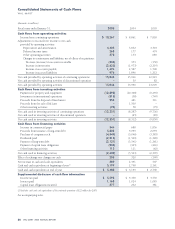Walmart 2005 Annual Report Download - page 39
Download and view the complete annual report
Please find page 39 of the 2005 Walmart annual report below. You can navigate through the pages in the report by either clicking on the pages listed below, or by using the keyword search tool below to find specific information within the annual report.
WAL-MART 2005 ANNUAL REPORT 37
1 Summary of Significant Accounting Policies
Consolidation
The consolidated financial statements include the accounts of
Wal-Mart Stores, Inc. and its subsidiaries (“Wal-Mart” or the
“company”). Significant intercompany transactions have been
eliminated in consolidation. Investments in which the company
has a 20 percent to 50 percent voting interest and where the
company exercises significant influence over the investee are
accounted for using the equity method.
The company’s operations in Argentina, Brazil, China, Germany,
Mexico, South Korea and the United Kingdom are consolidated
using a December 31 fiscal year-end, generally due to statutory
reporting requirements. There were no significant intervening
events which materially affected the financial statements. The
company’s operations in Canada and Puerto Rico are consolidated
using a January 31 fiscal year-end.
Cash and Cash Equivalents
The company considers investments with a maturity of three
months or less when purchased to be cash equivalents. The major-
ity of payments due from banks for third-party credit card, debit
card and electronic benefit transactions (“EBT”) process within
24-48 hours, except for transactions occurring on a Friday, which
are generally processed the following Monday. All credit card,
debit card and EBT transactions that process in less than seven
days are classified as cash and cash equivalents. Amounts due from
banks for these transactions classified as cash totaled $549 million
and $866 million at January 31, 2005 and 2004, respectively.
Receivables
Accounts receivable consist primarily of receivables from insurance
companies resulting from our pharmacy sales, receivables from
suppliers for marketing or incentive programs and receivables from
real estate transactions. Additionally, amounts due from banks for
customer credit card, debit card and EBT transactions that take in
excess of seven days to process are classified as accounts receivable.
Inventories
The company values inventories at the lower of cost or market as
determined primarily by the retail method of accounting, using the
last-in, first-out (“LIFO”) method for substantially all merchandise
inventories in the United States, except SAM’S CLUB merchandise,
which is based on average cost using the LIFO method. Inventories
of foreign operations are primarily valued by the retail method
of accounting, using the first-in, first-out (“FIFO”) method.
At January 31, 2005 and 2004, our inventories valued at LIFO
approximate those inventories if they were valued at FIFO.
Financial Instruments
The company uses derivative financial instruments for purposes
other than trading to manage its exposure to interest and foreign
exchange rates, as well as to maintain an appropriate mix of fixed-
and floating-rate debt. Contract terms of a hedge instrument
closely mirror those of the hedged item, providing a high degree
of risk reduction and correlation. Contracts that are effective at
meeting the risk reduction and correlation criteria are recorded
using hedge accounting. If a derivative instrument is a hedge,
depending on the nature of the hedge, changes in the fair value of
the instrument will either be offset against the change in fair value
of the hedged assets, liabilities or firm commitments through
earnings or recognized in other comprehensive income until the
hedged item is recognized in earnings. The ineffective portion of
an instrument’s change in fair value will be immediately recognized
in earnings. Instruments that do not meet the criteria for hedge
accounting or contracts for which the company has not elected
hedge accounting, are marked to fair value with unrealized gains
or losses reported in earnings.
Capitalized Interest
Interest costs capitalized on construction projects were $120 mil-
lion, $144 million, and $124 million in fiscal 2005, 2004, and
2003, respectively.
Long-lived Assets
Management reviews long-lived assets for indicators of impairment
whenever events or changes in circumstances indicate that the
carrying value may not be recoverable. The evaluation is done at
the lowest level of cash flows, which is typically at the individual
store level. Cash flows expected to be generated by the related
assets are estimated over the asset’s useful life based on updated
projections. If the evaluation indicates that the carrying amount
of the asset may not be recoverable, the potential impairment is
measured based on a projected discounted cash flow method
using a discount rate that is considered to be commensurate with
the risk inherent in the company’s current business model.
Goodwill and Other Acquired Intangible Assets
Goodwill is not amortized, rather it is evaluated for impairment
annually or whenever events or changes in circumstances indicate
that the value of certain goodwill may be impaired. Other acquired
intangible assets are amortized on a straight-line basis over the
periods that expected economic benefits will be provided. These
evaluations are based on discounted cash flows and incorporate
the impact of existing company businesses. The analyses require
significant Management judgment to evaluate the capacity of an
acquired business to perform within projections. Historically, the
company has generated sufficient returns to recover the cost of
the goodwill and other intangible assets.
Goodwill is recorded on the balance sheet in the operating segments
as follows (in millions):
January 31, 2005 January 31, 2004
International $ 10,498 $ 9,577
SAM’S CLUB 305 305
Total goodwill $ 10,803 $ 9,882
The change in the International segment’s goodwill is primarily
the result of foreign currency exchange rate fluctuations. The fiscal
2005 acquisition of Bompreço S.A. Supermercados do Nordeste
also resulted in an increase to goodwill.
Notes to Consolidated Financial Statements
W A L -M A R T
























